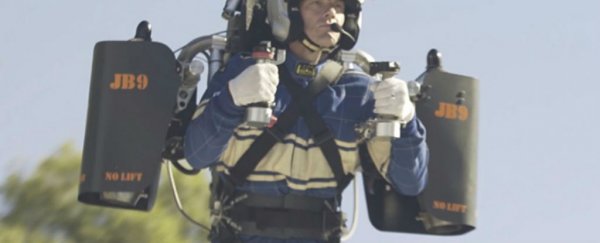Watching the footage below of a man gliding effortlessly above the water in the least bulky jetpack we've ever seen, all we can think about are the immortal words of Liz Lemon: "I want to go to there."
How do we go to there? We need to get our hands on the JB-9 jetpack from US-based tech company, Jetpack Aviation, which has been working on what they call "true" jetpacks for the past 40 years. This latest iteration can travel at speeds of up to 160 km/h (100 mph) for 10 minutes at a time, which is more than enough to get you where you need to go while looking like a total hero from the future.
So what's a "true" jetpack, I hear you ask? Good question, because like that other futuristic touchstone that's taking forever to become a part of our lives - the now infamous hoverboard - plenty of jetpacks have been thrown around in recent years, but until now, none of them have really looked right.
There's the Martin Jetpack, tipped to be the first commercial jetpack to go on sale some time this year, but you're going to have to fork out US$150,000 for one, and it's not exactly compact. (By that we mean it's like strapping a miniature aircraft to your body - still cool as hell if you're lucky enough to try it, but not something James Bond would be interested in.)
And there's the Jetman Dubai jetpack, which is technically more of a 'wingsuit system' that you have to strap yourself into and be launched from an aircraft more than 2 km in the air to achieve flight.
No, to achieve what we have in our minds as a proper personal jetpack, you have to meet certain criteria, as Evan Ackerman explains over at IEEE Spectrum:
"A real jetpack needs to be small and light enough that you can put it on and walk around. It needs to be safe enough and reliable enough (in principle if not in practice) for regular use. And most importantly, it needs to be able to take off vertically, fly for a useful distance and time, and land vertically without turning its passenger into goo. Jetpack Aviation's JB-9 does all of these things."

As Ackerman reports, the JB-9 runs on actual turbojet engines, which are no longer efficient enough to power big aircraft, but still offer an ideal power to weight ratio for a compact jetpack device. You just need to make sure you plug it with enough fuel, because it needs just under 4 litres of the stuff per minute - the device includes a 38-litre fuel tank.
Once you're in the air, you'll manoeuvre in the air using simple hand controls, or by leaning your body slightly to kickstart a nice roll. According to Jetpack Aviation, the jetpack can fly at an altitude of around 10,000 feet (30,480 metres) at speeds greater than 100 mph (160 km/h) and with an endurance of 10 minutes or more, depending on the pilot's weight.
"The JB-10 (which is already undergoing test flights) should be able to hit 'well over' 200 km/h in horizontal flight, and future improvements will thankfully include a ballistic parachute and sensor-driven automatic stabilisation to make the jetpack safer and easier to fly," Ackerman reports for IEEE Spectrum.
Unfortunately, the JB-9 or 10 won't be going on sale any time soon - they've put two decades into developing this version of the jetpack so far, they're not exactly going to cut corners now - and when they do, they're unlikely to be cheap.
But even if we're not going to see it in our homes any time soon, we can watch footage like this, of Jetpack Aviation CEO David Mayman soaring around the Statue of Liberty late last year, and know that the jetpack we've been waiting for is closer than ever. If only hoverboards looked half as hopeful.

